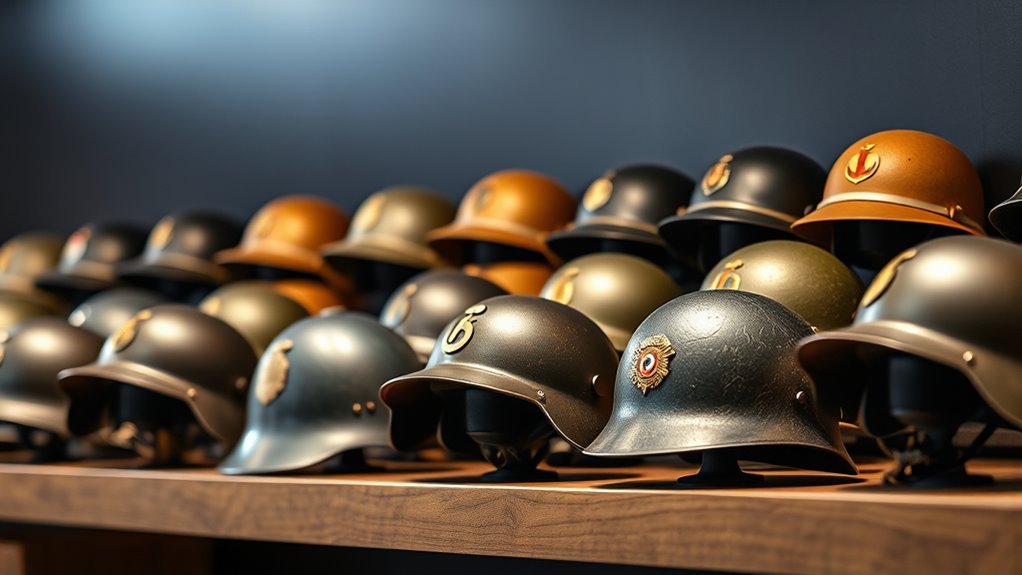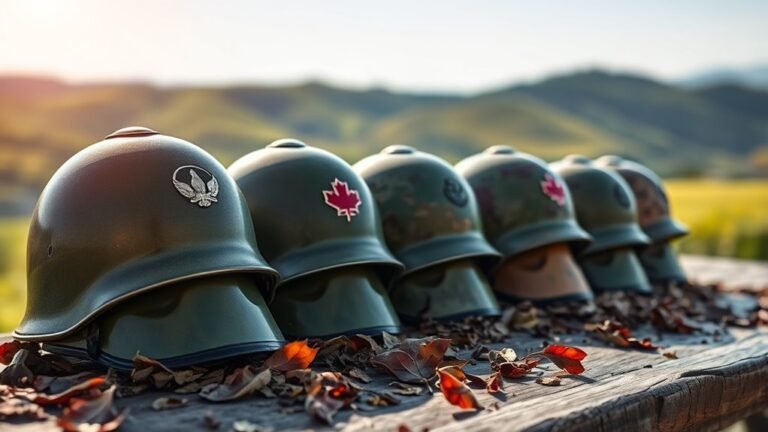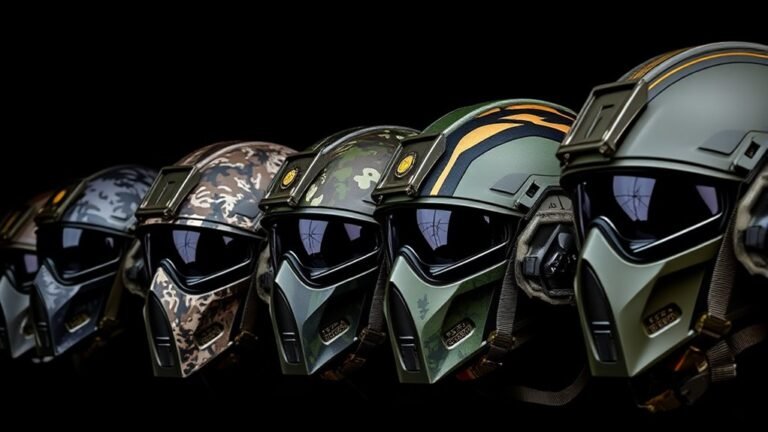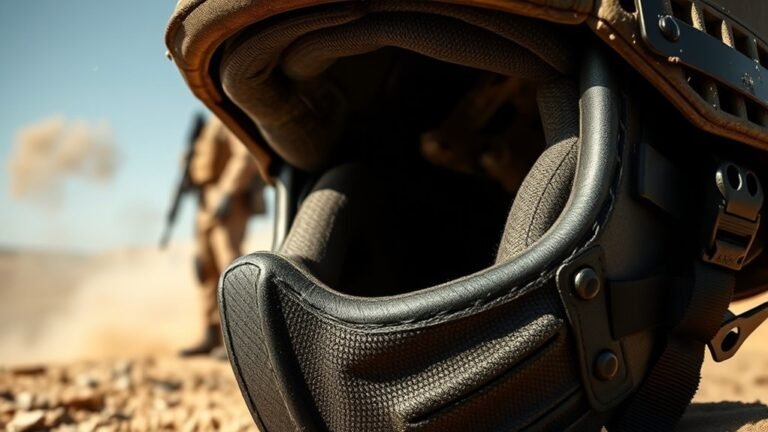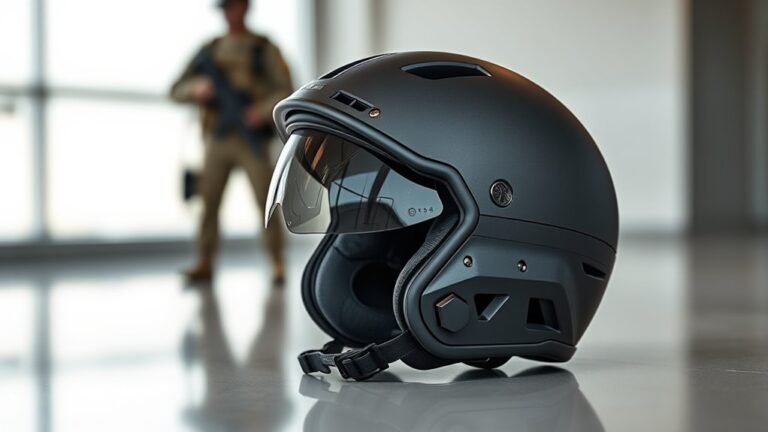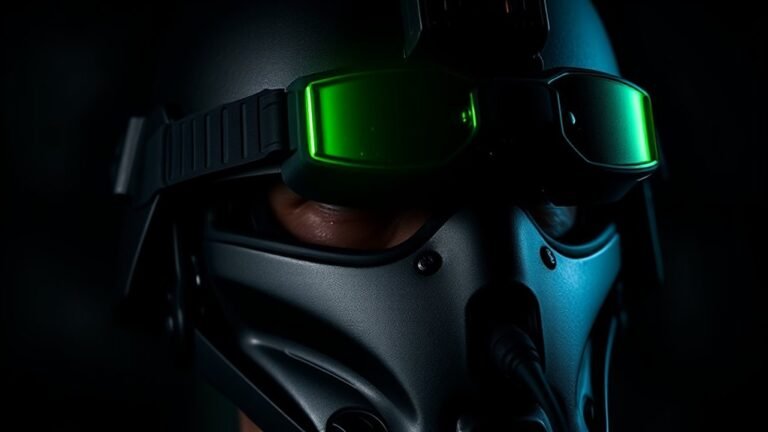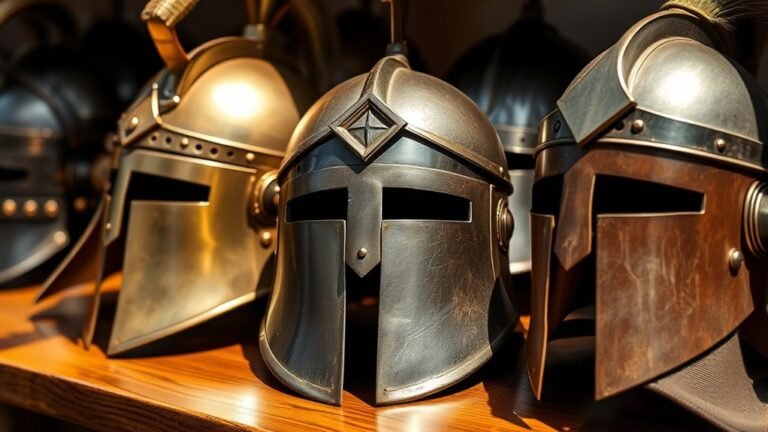Best Replica Military Helmets for Collectors
For collectors, the best replica military helmets combine historical significance with quality craftsmanship. The Classic WWII German Pickelhaube and the American M1 Helmet stand out for their iconic designs and detailing. The British Brodie Helmet symbolizes resilience, while the Japanese Type 90 offers unique aesthetics. Don’t overlook customizable options that reflect your personal style. Each piece tells a story, enhancing your collection. Discovering the right ones is just the beginning, as more fascinating options await you.
The Classic WWII German Pickelhaube
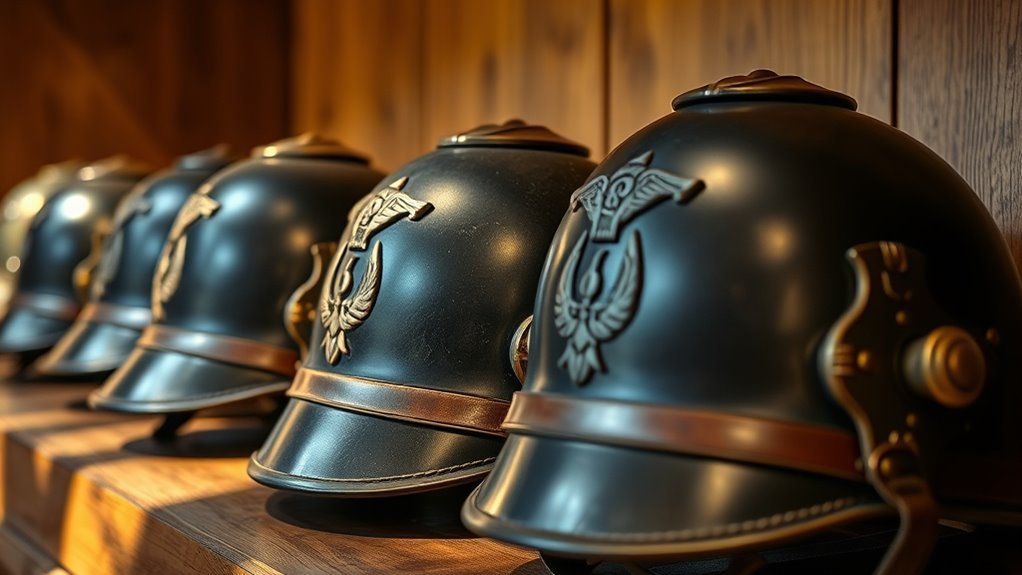
The Classic WWII German Pickelhaube, with its distinctive spike and ornate embellishments, stands as a symbol of militaristic pride and historical significance. Crafted from materials like metal, leather, and brass, the pickelhaube embodies not just military function but also cultural identity. Its spikes, often viewed as a representation of bravery, reflect an era where the symbolism of headgear mattered greatly on the battlefield. As you examine its detailed craftsmanship, you’ll appreciate how the pickelhaube served as a visual cue of rank and honor. This helmet transcends mere functionality; it evokes discussions about nationalism, tradition, and the complex narratives of war. For collectors, its historical symbolism makes the pickelhaube an essential piece of military heritage and a conversation starter.
American M1 Helmet: A Timeless Icon
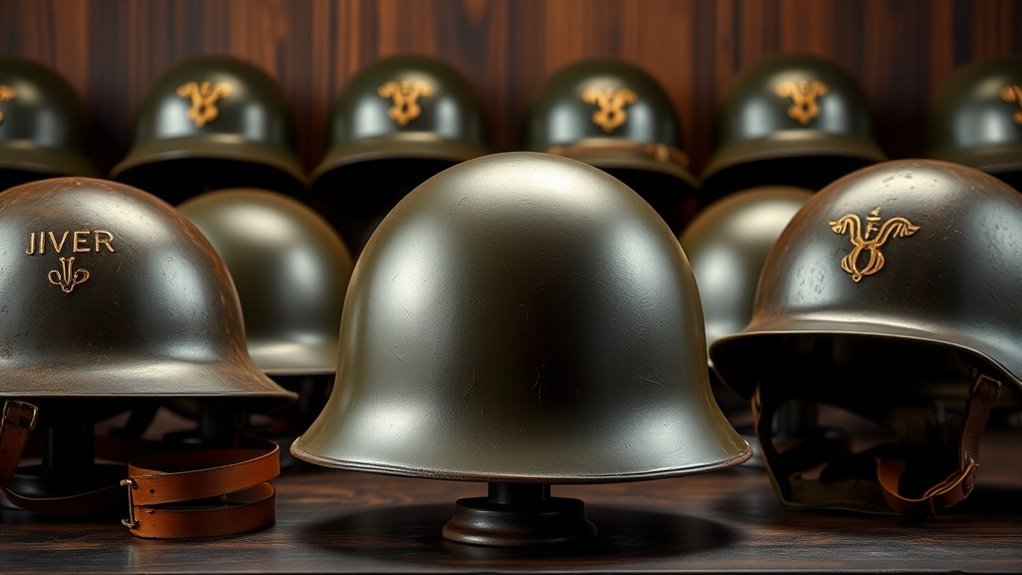
The American M1 helmet stands as a symbol of military innovation, embodying a rich history that spans multiple conflicts. Its distinctive design features and various models reflect both functionality and the evolving needs of soldiers over time. For collectors like you, understanding these elements can enhance your appreciation and guide your pursuit of authentic replicas.
Historical Significance of M1
Although many helmets have graced the battlefields throughout history, few have achieved the iconic status of the American M1 helmet. Its M1 development history began in the late 1930s, reflecting innovations that prioritized soldier safety and comfort. The M1’s combat usage spanned World War II, Korea, and beyond, making it a symbol of American military prowess.
Here’s a brief overview of key milestones:
| Year | Event |
|---|---|
| 1941 | Official adoption by the U.S. |
| 1944 | First major combat deployment |
| 1950 | Used extensively in the Korean War |
| 1980s | Phased out but remains iconic |
The M1’s design, functionality, and historical impact resonate with collectors and historians alike, embodying the spirit of freedom and resilience.
Design Features and Variants
When examining the design features and variants of the American M1 helmet, it’s clear that this iconic headgear was engineered with both functionality and durability in mind. Its exterior shell, crafted from high-quality steel, offers robust protection, while the interior features a webbing system that enhances comfort and fit. You’ll notice various design variations across different production years, such as changes in the liner materials—from fiberglass to plastic—which reflect advancements in helmet technology. The distinctive shape and the addition of a removable chin strap further highlight its practicality for soldiers in diverse combat scenarios. This combination of innovative helmet materials and thoughtful design guarantees that the M1 remains a timeless symbol of military craftsmanship.
Collecting Tips for Enthusiasts
Collecting military memorabilia can be an exhilarating journey, especially for those drawn to the American M1 helmet, a timeless icon of military history. To enhance your collection, adopt effective collecting strategies. Start by researching helmet provenance; knowing the history behind each piece adds immense value. Attend military shows and auctions to connect with fellow enthusiasts and gain insights into authentic helmets. When purchasing, always verify authenticity through trusted sources, ensuring you’re investing in genuine artifacts. Don’t overlook the importance of proper storage and display; preserving your helmets in controlled environments safeguards their condition. Engage with online forums to exchange tips and experiences, fostering a community that appreciates the freedom and legacy these helmets represent. Happy collecting!
British Brodie Helmet: A Symbol of Resilience
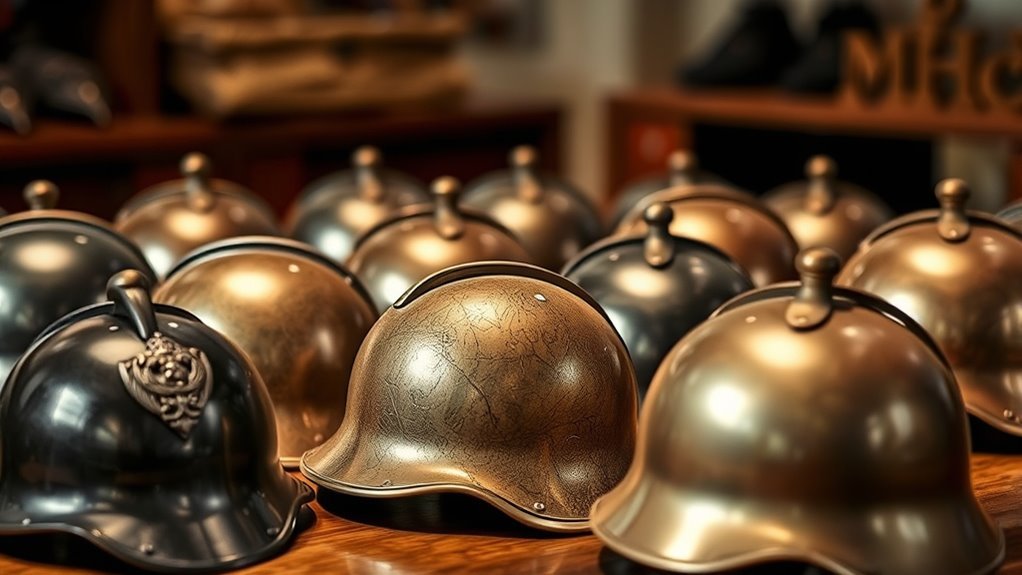
The British Brodie helmet stands as a symbol of the resilience of soldiers during World War I and beyond, embodying both historical significance and practical design. Its distinct features, such as the bowl shape and rimmed edge, reflect innovative adaptations to the realities of trench warfare. For collectors, understanding its history and design elements can enhance your appreciation and inform your pursuit of authentic replicas.
Historical Significance of Brodie
Resilience defines the British Brodie helmet, an iconic piece of military history that emerged during World War I. This helmet not only protected soldiers but also symbolized the Brodie legacy and wartime innovations that shaped modern warfare. Its historical significance can be highlighted through:
- The evolution of soldier safety in combat.
- A shift in military gear design emphasizing functionality.
- Its role in fostering national identity during the war.
- The influence on future helmet designs for various armies.
- Its status as a collector’s item, representing a pivotal era in history.
As you explore the Brodie helmet, you’ll appreciate its lasting impact on military culture and how it embodies the spirit of resilience amidst the chaos of war.
Design and Features Explained
Crafted for both protection and practicality, the British Brodie helmet showcases a design that revolutionized headgear in military operations. Its distinctive dome shape and wide brim were innovative design techniques aimed at deflecting shrapnel and debris, providing soldiers with enhanced safety. The helmet’s material choices, primarily steel, offered durability while remaining lightweight, ensuring that it could withstand the rigors of battle without hindering movement. The interior padding and chin straps were thoughtfully designed for comfort and secure fit, allowing soldiers to wear the helmet for extended periods. This combination of form and function not only symbolizes resilience but also represents a commitment to soldier welfare, reflecting a profound understanding of the demands of warfare and the need for freedom in every engagement.
Collecting Tips for Enthusiasts
While diving into the world of collecting British Brodie helmets, it’s essential to evaluate authenticity and condition as key factors that can greatly influence your purchase. Here are some effective collection strategies and display ideas to enhance your hobby:
- Research specific markings and historical context for authenticity.
- Inspect for wear and tear that may affect value.
- Network with fellow collectors for insights and advice.
- Consider environmental factors when displaying to prevent damage.
- Use shadow boxes or stands to showcase your helmets attractively.
The Japanese Type 90 Helmet: A Unique Design
The Japanese Type 90 helmet stands out in military history due to its innovative design and practical features. This helmet represents a significant evolution in protective headgear, merging traditional Japanese craftsmanship with modern military needs. Its unique shape, characterized by a distinctive ridge along the top, not only enhances its aesthetic appeal but also contributes to structural integrity. The Type 90’s lightweight materials and adjustable chin straps guarantee comfort for extended wear, a vital consideration for soldiers. As you explore replica options, pay close attention to the details that reflect this helmet’s heritage, such as the authentic paint finish and liner design. Collecting these replicas allows you to appreciate the Type 90’s role in military history while celebrating Japanese craftsmanship.
Modern Tactical Helmets: Blending Functionality and Style
Modern tactical helmets represent the forefront of protective headgear, merging cutting-edge technology with contemporary design aesthetics. As a collector, you’ll appreciate how these helmets encompass tactical advancements while offering a stylish flair. They’re designed not just for functionality but also to enhance your overall gear’s look. Key features often include:
- Lightweight materials for comfort
- Adjustable straps for a secure fit
- Modular systems for helmet accessories
- Noise-canceling communication devices
- Advanced ventilation systems
These helmets are often customizable, allowing you to express your individual style while ensuring exceptional protection. By embracing modern tactical helmets, you’re not only investing in safety but also in a piece of equipment that reflects your passion for freedom and personal expression.
The Italian M33 Helmet: A Blend of Form and Function
A true icon of military headgear, the Italian M33 helmet showcases an impressive combination of design and practicality. Its design evolution reflects a commitment to both aesthetics and soldier safety, utilizing sturdy helmet materials like steel for durability. You’ll appreciate how its streamlined shape not only enhances comfort but also offers superior protection in combat scenarios.
| Feature | Description | Impact |
|---|---|---|
| Design | Streamlined, minimalist | Reduced weight and bulk |
| Materials | Steel construction | Enhanced durability |
| Interior Padding | Leather and fabric | Improved comfort |
| Ventilation | Strategic holes | Better airflow |
| Color Variations | Olive drab, grey | Camouflage effectiveness |
The M33 remains a must-have for collectors who value both form and function.
Replica Helmets of the Vietnam War Era
Replica helmets from the Vietnam War era offer collectors a fascinating glimpse into the military’s evolution during a tumultuous period. These helmets are more than just iconic headgear; they’re historical replicas that showcase unique helmet designs used in a complex conflict. When diving into this niche of military collectibles, consider the following tips:
- Look for authentic markings and insignia.
- Choose helmets with varied finishes, like the classic olive drab.
- Assess the condition; some wear adds character.
- Research different units and their specific helmet styles.
- Verify provenance to guarantee historical accuracy.
The French Adrian Helmet: A Historical Marvel
The French Adrian helmet, with its distinctive design and innovative features, stands as a demonstration to military engineering of its time. Its unique shape not only provided enhanced protection but also reflected the evolving tactics of World War I. Understanding its historical significance offers you insight into how this helmet influenced both design trends and soldier safety in subsequent conflicts.
Design and Features
While collectors often admire the aesthetics of military helmets, the French Adrian Helmet stands out not only for its unique design but also for its rich historical significance. This helmet showcases several notable design innovations and utilizes advanced helmet materials of its time.
- Distinctive, sleek profile enhances comfort and mobility
- Made from high-quality steel, providing durability
- Offered various regimental insignias, personalizing each piece
- Unique brass fittings add an elegant touch
- Ventilation holes improve airflow, preventing overheating
These features not only reflect the craftsmanship of the era but also demonstrate a commitment to both functionality and style. The Adrian Helmet is a symbol of the evolution of military headgear, embodying both practicality and artistry.
Historical Significance
Although often overshadowed by more famous military headgear, the French Adrian Helmet represents a pivotal moment in the evolution of combat protection. Introduced during World War I, it emerged in a historical context where soldiers faced unprecedented dangers on the battlefield. Its design reflected not just practicality but also a cultural impact, symbolizing a departure from traditional warfare aesthetics. The helmet’s distinctive shape and materials prioritized both safety and comfort, influencing helmet designs globally. By embracing modern technology and innovative design, the Adrian Helmet became a beacon of progress in military gear. For collectors, it’s more than just a replica; it’s a tribute to a transformative era, embodying the spirit of freedom and resilience that defined a generation of soldiers.
Customizable Replica Helmets: Personalizing Your Collection
When you immerse yourself in the world of customizable replica helmets, you’ll discover a unique opportunity to express your personal style and enhance your collection. Personalization isn’t just about aesthetics; it’s about creating a piece that resonates with you. Here are some ways to customize:
- Add custom artwork that reflects your interests or values.
- Integrate unique helmet accessories like decals or patches.
- Experiment with different paint finishes for a distinct look.
- Choose liner colors that match your theme or personal taste.
- Incorporate personalized labels or engravings for a signature touch.
With these options, you can transform a standard replica into a statement piece, making your collection not just visually appealing but also deeply personal. Embrace your creativity and let your helmets tell your story!
How to Care for and Display Your Replica Helmets
After personalizing your replica helmets, the next step is ensuring they remain in pristine condition and are displayed effectively. Proper helmet storage is essential; use padded boxes or display cases that protect against dust and sunlight. Avoid stacking helmets to prevent deformation. When it comes to display techniques, consider wall-mounted shelves or stands that elevate your helmets, allowing for 360-degree visibility. Utilize LED lighting to highlight details without generating heat, which can damage materials over time. Regularly dust your helmets with a microfiber cloth, and avoid using harsh chemicals. By maintaining careful storage and employing thoughtful display techniques, you not only preserve the integrity of your collection but also create an engaging showcase that reflects your passion for military history.
Frequently Asked Questions
Where Can I Buy High-Quality Replica Military Helmets?
You can buy high-quality replica military helmets from various online retailers and specialty shops. Look for websites that focus on military memorabilia, as they often carry a wide selection. Check customer reviews to guarantee the quality and authenticity of the helmets. Specialty shops, particularly those that cater to collectors, can provide expert advice and unique finds. Always verify the reputation of the seller to ascertain you’re getting a product that meets your standards.
Are Replica Helmets Safe to Wear?
Wearing a replica helmet can feel like donning a shield from history, but you need to tread carefully. While many replica helmets boast impressive authenticity and quality, they’re not designed for actual protection. Authenticity in construction often means they’re visually stunning but lack the safety features of real military gear. If you’re looking for something to wear, make certain it’s a certified replica meant for use, not just display. Your safety should always come first!
How Do I Determine the Value of My Helmet?
To determine the value of your helmet, consider its history, rarity, and condition. Research similar helmets to gauge market pricing factors, like demand and production year. Authenticity plays an essential role; make certain you can verify its origins. Examine any unique features or markings, as these can enhance its worth. By analyzing these elements, you’ll gain a clearer understanding of your helmet’s value in the collector’s market.
Can I Find Replicas of Specific Military Units?
Yes, you can find military unit replicas, including specific unit helmets. Many online retailers and specialty shops focus on reproducing authentic designs. When searching, consider the specific unit you’re interested in, as some may have dedicated manufacturers. Look for detailed descriptions, quality materials, and customer reviews to guarantee authenticity. Joining collector forums can also guide you to trusted sources and fellow enthusiasts who share your passion for military history and memorabilia.
What Materials Are Commonly Used in Replica Helmets?
When you plunge into the world of replica helmets, think of the materials as the backbone of your treasure. Most commonly, you’ll find fiberglass, plastic, and sometimes even metal in helmet construction. Fiberglass offers durability while staying lightweight, perfect for display. Plastic’s affordability makes it a popular choice, while metal adds an authentic touch, though it can be heavier. Each material plays an essential role in ensuring your helmet not only looks good but lasts.
